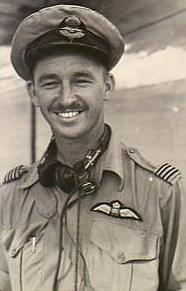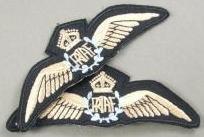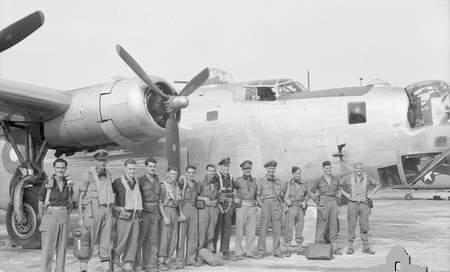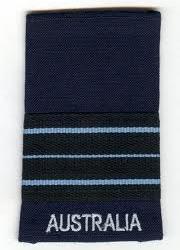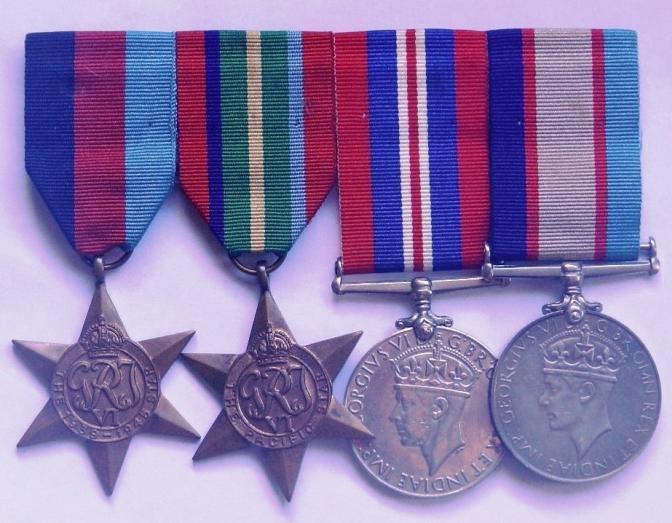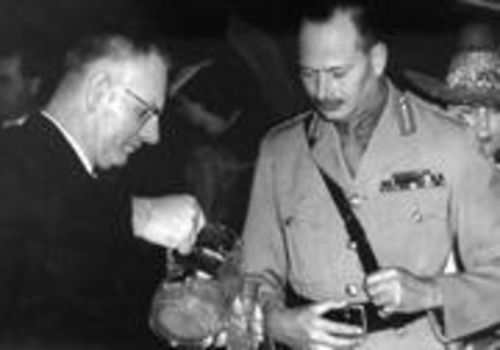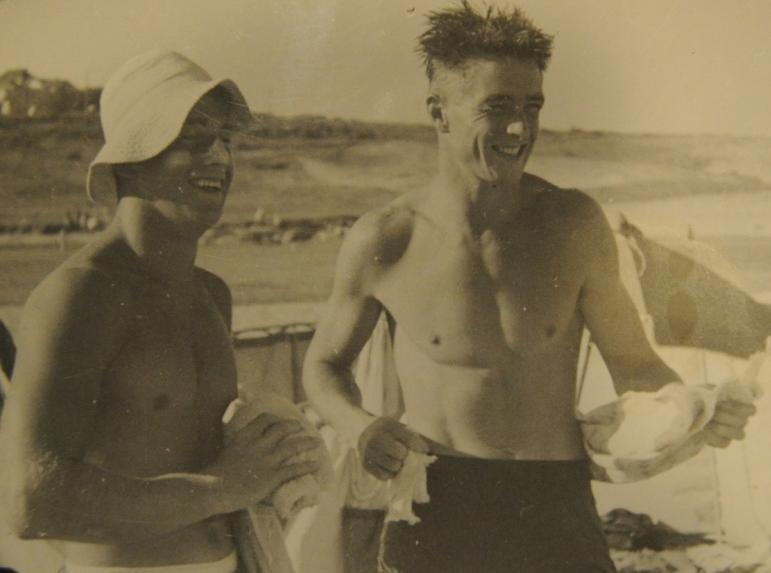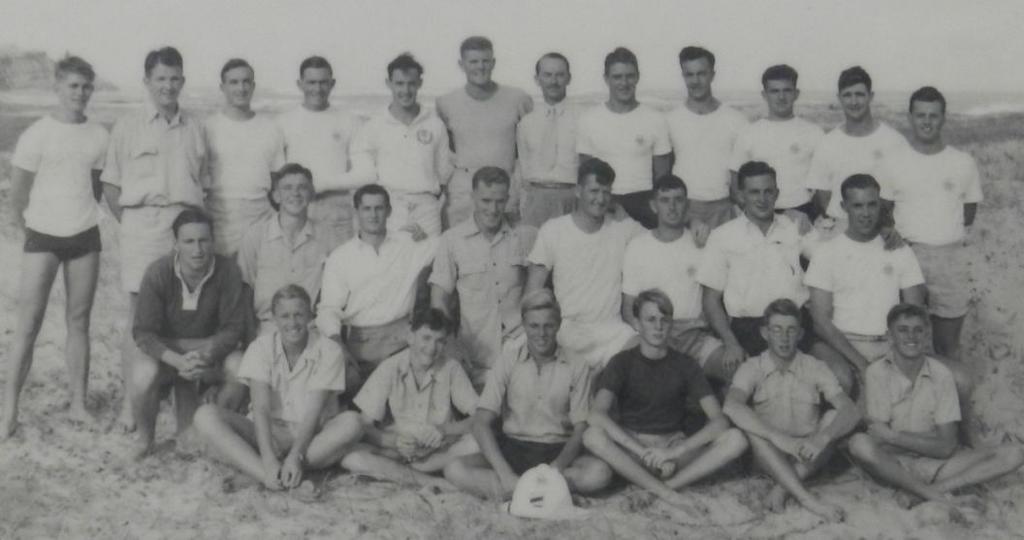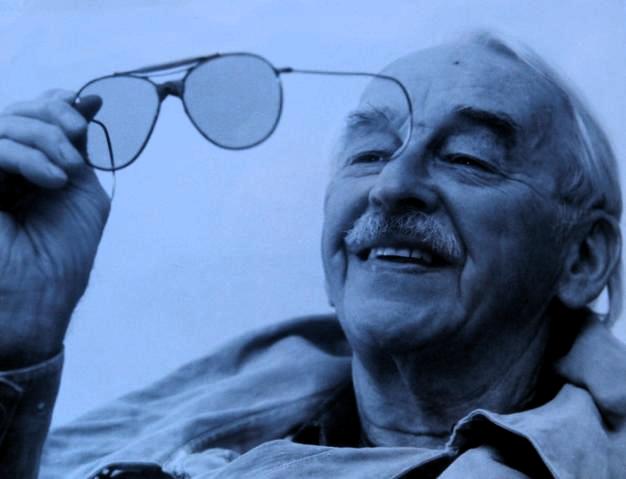Roger Court: 1912 - 1997
Roger was born in Bristol, England in 1912 and came to Australia at age 11 in 1923 with his mother, father and brother. Roger was one of four, with two elder sisters who remained in England. Roger loved the lifestyle on the Northern Beaches, the sun and the sand, compared with the weather of mother England. Roger initially lived in Bondi and later moved to Collaroy. Roger used to get the tram down to Narrabeen Lake to some holiday cottages to enjoy the lake & surf atmosphere.
Roger had always taken an interest in being a mechanic or engineer. Roger applied and successfully past the trades test for the Royal Australian Air Force. Jobs during the 1930swere difficult to come by due to the great depression and numerous men of Roger’s agelooked to the defence force. Roger was required to report to Victoria Barracks down in Victoria on the 18th January 1938. On this day 45 new recruits assembled. After passing his medical Roger was then sent to the RAAF Laverton where he was fitted out with his uniform and the drill training commenced. After training, Roger was successful in becoming an Aircraftman First Class and was posted to No. 6 Squadron, Richmond NSW. Whilst working at Richmond Roger undertook training as an Air Gunnery using the Lewis Machine gun.
Before the war the RAAF would recruit five airman each year from the ranks to be trained as pilots. A notice went up and so Roger applied and was successful passing the prerequisite trigonometry exam. On the 5th June, 1938 Roger commenced his training as a pilot. Within 4 hours and 40 minutes Roger was flying solo, which was an RAAF record, beating the previous 9 hours, and Roger was successful in achieving his wings.
On 3rd September 1939 England declared war with Germany. The RAAF commenced a massive air training system to train pilots, navigators, wireless operators, bomb aimers and air-gunners. Roger was posted to Central Flying School at Camden NSW in February 1941 as an instructor training pilots in Tiger Moths. Roger continued to train pilots on Tiger Moths until 3rd August 1942, when he was transferred to Central Flying School in Tamworth NSW. It was at this time his first son was born on 21st August 1942, Peter Baden Court.
Roger was then posted to 71st Reserve Squadron at Bundaberg, Queensland to patrol for submarines along the east coast of Australia. Usually they flew at 1,000 feet but if visibility was bad, they would fly as low as 100 feet. Roger remained as an instructor until 17th June 1944, when he was deployed to No. 7 (Operational Training Unit, Tocumwal NSW). Roger was one of a number of Senior Flying Instructors.
Roger and his crew then started training on the Liberator B-24. After being trained Roger and his crew flew to Nabzab in New Guinea. This was an American Air Force Base of the 380th Bomb Group which flew Liberators and lots of them. Roger and his crew commenced bombing operations of Rabaul.
In December 1944 Roger and his crew were posted to RAAF 24th Squadron. The squadron was formed in September 1940 to carry out maritime, reconnaissance and training duties. Following Japan’s entry into the war in December 1941 the squadron moved to Rabaul in an attempt to provide some defence to New Britain.
The squadron became one of the first squadrons to be re-equipped with the Consolidated Liberator, a heavy bomber. They moved to the Northern Territory, first to Manbulloo and then, in September, to Fenton. At Fenton, the squadron became part of 82nd (Heavy Bomber) Wing and conducted bombing raids against targets in the Netherlands East Indies. Between January and April 1945 attacks were made on power stations in east Java, an enemy convoy near Koepang, and troop concentrations at Tawao. A detachment of aircraft was also sent to Morotai to assist in raids on Labuan, Tanamon, Borneo, and islands in the Netherlands East Indies.
On 28th April 1945, Roger was commissioned as Officer Commanding of the 24th Squadron to lead an aircraft bombing strike on the Boro Bora airfield, itself a fighter base. While the bombing run was taking place the Japanese had anti-aircraft radar and ground predicted fire, and they were getting all the data they needed. This included height, course and airspeed data to feed into their equipment, which resulted in the shells exploding all around Roger’s squadron. Roger stated that the aircraft would give a severe jolt when flying through the explosion and the resulting smoke filled the aircraft with the smell of cordite but that was better than a direct hit. The RAAF continued to bomb the Japanese airfields which allowed for the invasion of Borneo by AIF ground troops. The squadron motto was “Attack so you may defend”. During the war the Squadron saw action in the Pacific, Darwin, Rabaul, New Guinea, New Britain, Markham Valley, Morotai and Borneo. As with all Bomber commands the Squadron had a high number of casualties with 105 giving their life in the protection of Australian and our way of life. As the war came to an end and the Allies began gaining control over the Japanese, Roger was quoted as saying it was “a welcome change bashing the Japanese”.
On the 13th June 1945, Roger flew his last mission with 47 strikes over enemy held territory before returning to Darwin. Roger was then posted to ferrying new Liberators from America to Australia. All this equipment was given to Australia by the Americans. Following the war, Roger ended up spending 9 months in America on full pay awaiting transport back to Australia as the ships had been being used to transport troops home.
Roger returned to Australia in 1946 and was meet by Wing Commander Bell. Whilst many pilots were discharging Commander Bell asked if Roger would be interested in flying the Governor General’s flight, and the Governor General that at the time was H.R.H. The Duke of Gloucester. Roger stated he had no immediate plans and so accepted.
After being away for some years, Roger spent 2 or 3 weeks with his wife Alison and two children in their rented cottage in Collaroy before reporting to the Governor Generals' RAAF Base outside of Canberra. Roger was to fly the Arvo York aircraft with four Rolls Royce engines.
For those with an interest, the Liberator heavy bomber was produced in greater numbers than any other US combat aircraft during the Second World War. Originally developed to provide the US Army Air Force (USAAF) with a heavy bomber of superior performance to the B-17, the Liberator prototype first flew in December 1939, and production aircraft entered service with both the USAAF and Britain's Royal Air Force (RAF) in early 1941. Ultimately, 18,482 Liberators were produced until May, 1945. In addition to being employed as a heavy bomber in all of the major theatres in which the western allies fought, Liberator variants were also used for maritime patrol operations and as transporters.
Royal Australian Air Force Squadrons, however, only operated Liberators in the South-West Pacific Area. In order to relieve the burden on the USAAF's 380th Bombardment Group, the Commander Allied Air Forces South-West Pacific recommended that the RAAF form seven Liberator squadrons. A total of 287 Liberators saw service as heavy bombers with the RAAF in 12th, 21st, 23rd, 24th, 25th, 99th and 102nd Squadrons, and on covert and electronic surveillance missions with 200 and 210 Flights. The Liberator's capabilities proved particularly devastating during the Australian operations around Borneo. Liberators remained in service with the RAAF until 1948 and could have remained in service much longer had not the decision been made to commence local production of the Avro Lincoln. Roger, working with several other pilots, flew the Duke to his many public engagements around Australia and Roger, being a likable fellow, was always sought out by the Duke for a chat. Roger admits that this time was very hard on his marriage with Alison being away for so much of the time. At times Roger stated that flying the Duke was a difficult task as the Avro York was too large to land on many of the runways around Australia. Roger recounts several trips, including the Royal Visit to Queensland on the 27th May 1946.
In January 1947, preparations were made for the termination of the Duke and Duchess as Governor General of Australia, and Roger and Wing Commander Bell were to fly them back to London. Upon arriving in London, Roger was meet by his two sisters who he had not seen for over 10 years. After a few weeks of rest Roger was selected to attend the Central Flying School in England, which was considered the greatest University of Flying in the world.
Roger started his posting here on the 10th April, 1947. Roger had made repeated inquires about returning to Australia but there were no overseas airlines or passenger ships. Roger was selected as 1 of 30 officers from the British Empire to do a 3 month course. It was here that Roger was allowed to take a Mark 8 Spitfire in the air, which Roger recounts as being simply an amazing trill. Roger just said she performed beautifully, a marked change from flying larger bombers. On 10th July 1947, Squadron Leader Court attended Buckingham Palace and, on this date, Roger Court and Commander Bell had tea with the King and Queen of England followed by Princess Elizabeth and Phillip. It was on this day they announced their engagement. Some weeks later Roger and others from the Duke’s crew reported to the RAAF HQ in London and was asked to fly three Bristol Freighters to Australia. Roger thought these were dangerous aircraft and declined. Later the RAAF pilots who accepted the task died in crashes. Roger was asked to do another short mission, which he declined, and managed to get on an Orion, the first passenger vessel to leave England since the war, which docked in Australia in January 1948. Roger was discharged from the RAAF on the 6th April 1948.
Roger’s first concern was to find a suitable home for his family and Roger bought a place in Collaroy Plateau overlooking Long Reef. At the end of World War II barbed wire, tank traps and sandbags were cleared from Sydney’s beaches and a few years later food and petrol rationing was lifted. Long Reef Beach had been one such beach determined to be easy landing access for enemy forces.
The FX Holden, Australia’s first people’s car, hit the road in 1948. That same year, the 40-hour week was introduced, with workers getting a full weekend off. Almost overnight, leisure and mobility had become a cultural birth right. As surf-starved Sydneysiders headed back to the beaches, membership of lifesaving clubs swelled. A blokey, authoritarian, army-like culture appealed to returned soldiers. Suntanned bodies, vigorous fun, new-found freedoms and easy access to alcohol grabbed hold of post-war teens. And, sure enough, lifesavers were popular with the girls on the beach. Throughout the 1950s, magazines, books, advertisements and tourism campaigns championed the image of surfers, seaside pleasures and sun-loving families. Australia’s so-called ‘way of life’ had left the outback and headed to the coast. The 1950’s were a period of growth and development for Sydney and Australia. The 1950s were prosperous, vibrant years for Australians. Employment was high and people were encouraged to spend their money freely. Technology advanced rapidly after the war and soon transformed the lives of many Australians. Televisions provided a link to the rest of the world and cars gave people a new mobility that would change the nation's patterns of leisure and living. Women were encouraged to stay at home, raise children and care for their husbands. To assist in the homemaking task, shiny new home appliances promised to transform housekeeping into a delight.
In 1954, thousands of people queued to welcome Queen Elizabeth II when she visited Australian shores. Many Australians still considered Britain to be their homeland and proclaimed unwavering loyalty to British culture and values. Throughout the 1950s, a flood of migrants transformed the shape of Australian society.
Australia suffered a huge shortage of workers for the nation's reconstruction efforts and the nation embarked on a programme to boost its population. In 1950, it was estimated that 170,000 migrants arrived in Australia. By the end of the decade, this figure would reach one million. Most migrants hailed from Britain, or European countries, such as Greece and Italy. They had a major impact on the make-up of the Australian population and introduced new food, music, religion and traditions to Australian cultural life.
Roger had always had an interest in building. The US had begun using foam concrete building blocks and Roger returned with this idea to Australia. Roger started work with Foam Concrete Pty Ltd to make light weight foaming product and started production in St Peters. Business was good for about 2 years before a recession hit which put Roger’s company out of business.
During this time Roger had been instrumental in lobbying local authorities for a licence for the Collaroy RSL. (Now called the Services Beach Club) and Roger, as a local, got to know the Urquhart family in particular Alistair who lived nearby in Hay Street. Alistair was a local business man who was was heavily involved in community works whilst working as a stockbroker and Director of Chubb Security Holdings. In 1950 Alistair asked Roger if he would be the figurehead for the club since he was a well-known community member within Collaroy. Roger had been actively involved in setting up the Collaroy RSL club. The agreement was that Roger would be the President of the club and Alistair would stand as the Vice President. Roger accepted this invitation although neither Roger nor Alistair held their Bronze Medallion Awards and therefore became Associate members of the club. Roger was aged 38 when he took the position as Club President in 1950. On 8th October, 1950 a sign was erected which read, “Long Reef Beach and Surf Club”. The season of 1954/55 was Roger's last season as President; after 5 enjoyable seasons. It was during this time - having started with nothing - that the club grew in strength as its membership increased.
In 1954, after Roger’s building company folded, Roger got a job through a mate to train as a Flight Engineer with Qantas flying the Sandringham Flying Boat and in April 1954, Roger past his final checks. After 18 months the Flying Boats ceased operations in Australia. Roger was away for considerable periods of time and stood down as President. He served one season as the Vice President to assist Neil Jones who took over as the club's second President. Whilst Roger removed his involvement in club administrations in 1956, he returned to the club again as Vice President in 1960-61 and 1961-62. Roger continued to work as a Flying Engineer for many years working on 707 flights all over the world.
Sadly. he passed away aged 85 in 1997. Roger left 3 children, Peter the eldest, Robin and Timothy.
Roger Court: 1912 - 1997
Roger was born in Bristol, England in 1912 and came to Australia at age 11 in 1923 with his mother, father and brother. Roger was one of four, with two elder sisters who remained in England. Roger loved the lifestyle on the Northern Beaches, the sun and the sand, compared with the weather of mother England. Roger initially lived in Bondi and later moved to Collaroy. Roger used to get the tram down to Narrabeen Lake to some holiday cottages to enjoy the lake & surf atmosphere.
Roger had always taken an interest in being a mechanic or engineer. Roger applied and successfully past the trades test for the Royal Australian Air Force. Jobs during the 1930swere difficult to come by due to the great depression and numerous men of Roger’s agelooked to the defence force. Roger was required to report to Victoria Barracks down in Victoria on the 18th January 1938. On this day 45 new recruits assembled. After passing his medical Roger was then sent to the RAAF Laverton where he was fitted out with his uniform and the drill training commenced. After training, Roger was successful in becoming an Aircraftman First Class and was posted to No. 6 Squadron, Richmond NSW. Whilst working at Richmond Roger undertook training as an Air Gunnery using the Lewis Machine gun.
Before the war the RAAF would recruit five airman each year from the ranks to be trained as pilots. A notice went up and so Roger applied and was successful passing the prerequisite trigonometry exam. On the 5th June, 1938 Roger commenced his training as a pilot. Within 4 hours and 40 minutes Roger was flying solo, which was an RAAF record, beating the previous 9 hours, and Roger was successful in achieving his wings. Photo2.
On 3rd September 1939 England declared war with Germany. The RAAF commenced a massive air training system to train pilots, navigators, wireless operators, bomb aimers and air-gunners. Roger was posted to Central Flying School at Camden NSW in February 1941 as an instructor training pilots in Tiger Moths. Roger continued to train pilots on Tiger Moths until 3rd August 1942, when he was transferred to Central Flying School in Tamworth NSW. It was at this time his first son was born on 21st August 1942, Peter Baden Court.
Roger was then posted to 71st Reserve Squadron at Bundaberg, Queensland to patrol for submarines along the east coast of Australia. Usually they flew at 1,000 feet but if visibility was bad, they would fly as low as 100 feet. Roger remained as an instructor until 17th June 1944, when he was deployed to No. 7 (Operational Training Unit, Tocumwal NSW). Roger was one of a number of Senior Flying Instructors.
Roger and his crew then started training on the Liberator B-24. After being trained Roger and his crew flew to Nabzab in New Guinea. This was an American Air Force Base of the 380th Bomb Group which flew Liberators and lots of them. Roger and his crew commenced bombing operations of Rabaul.
In December 1944 Roger and his crew were posted to RAAF 24th Squadron. The squadron was formed in September 1940 to carry out maritime, reconnaissance and training duties. Following Japan’s entry into the war in December 1941 the squadron moved to Rabaul in an attempt to provide some defence to New Britain.
The squadron became one of the first squadrons to be re-equipped with the Consolidated Liberator, a heavy bomber. They moved to the Northern Territory, first to Manbulloo and then, in September, to Fenton. At Fenton, the squadron became part of 82nd (Heavy Bomber) Wing and conducted bombing raids against targets in the Netherlands East Indies. Between January and April 1945 attacks were made on power stations in east Java, an enemy convoy near Koepang, and troop concentrations at Tawao. A detachment of aircraft was also sent to Morotai to assist in raids on Labuan, Tanamon, Borneo, and islands in the Netherlands East Indies.
On 28th April 1945, Roger was commissioned as Officer Commanding of the 24th Squadron to lead an aircraft bombing strike on the Boro Bora airfield, itself a fighter base. While the bombing run was taking place the Japanese had anti-aircraft radar and ground predicted fire, and they were getting all the data they needed. This included height, course and airspeed data to feed into their equipment, which resulted in the shells exploding all around Roger’s squadron. Roger stated that the aircraft would give a severe jolt when flying through the explosion and the resulting smoke filled the aircraft with the smell of cordite but that was better than a direct hit. The RAAF continued to bomb the Japanese airfields which allowed for the invasion of Borneo by AIF ground troops. The squadron motto was “Attack so you may defend”. During the war the Squadron saw action in the Pacific, Darwin, Rabaul, New Guinea, New Britain, Markham Valley, Morotai and Borneo. As with all Bomber commands the Squadron had a high number of casualties with 105 giving their life in the protection of Australian and our way of life. As the war came to an end and the Allies began gaining control over the Japanese, Roger was quoted as saying it was “a welcome change bashing the Japanese”.
On the 13th June 1945, Roger flew his last mission with 47 strikes over enemy held territory before returning to Darwin. Roger was then posted to ferrying new Liberators from America to Australia. All this equipment was given to Australia by the Americans. Following the war, Roger ended up spending 9 months in America on full pay awaiting transport back to Australia as the ships had been being used to transport troops home.
(This photo3 is Roger with his crew in 1945 just before it taxied out to set off on a strafing mission from the Liberators New Western Philippines Base.) Roger returned to Australia in 1946 and was meet by Wing Commander Bell. Whilst many pilots were discharging Commander Bell asked if Roger would be interested in flying the Governor General’s flight, and the Governor General that at the time was H.R.H. The Duke of Gloucester. Roger stated he had no immediate plans and so accepted. Photo_4 & photo_5.
After being away for some years, Roger spent 2 or 3 weeks with his wife Alison and two children in their rented cottage in Collaroy before reporting to the Governor Generals' RAAF Base outside of Canberra. Roger was to fly the Arvo York aircraft with four Rolls Royce engines.
For those with an interest, the Liberator heavy bomber was produced in greater numbers than any other US combat aircraft during the Second World War. Originally developed to provide the US Army Air Force (USAAF) with a heavy bomber of superior performance to the B-17, the Liberator prototype first flew in December 1939, and production aircraft entered service with both the USAAF and Britain's Royal Air Force (RAF) in early 1941. Ultimately, 18,482 Liberators were produced until May, 1945. In addition to being employed as a heavy bomber in all of the major theatres in which the western allies fought, Liberator variants were also used for maritime patrol operations and as transporters.
Royal Australian Air Force Squadrons, however, only operated Liberators in the South-West Pacific Area. In order to relieve the burden on the USAAF's 380th Bombardment Group, the Commander Allied Air Forces South-West Pacific recommended that the RAAF form seven Liberator squadrons. A total of 287 Liberators saw service as heavy bombers with the RAAF in 12th, 21st, 23rd, 24th, 25th, 99th and 102nd Squadrons, and on covert and electronic surveillance missions with 200 and 210 Flights. The Liberator's capabilities proved particularly devastating during the Australian operations around Borneo. Liberators remained in service with the RAAF until 1948 and could have remained in service much longer had not the decision been made to commence local production of the Avro Lincoln. Roger, working with several other pilots, flew the Duke to his many public engagements around Australia and Roger, being a likable fellow, was always sought out by the Duke for a chat. Roger admits that this time was very hard on his marriage with Alison being away for so much of the time. At times Roger stated that flying the Duke was a difficult task as the Avro York was too large to land on many of the runways around Australia. Roger recounts several trips, including the Royal Visit to Queensland on the 27th May 1946. Photo_6
In January 1947, preparations were made for the termination of the Duke and Duchess as Governor General of Australia, and Roger and Wing Commander Bell were to fly them back to London. Upon arriving in London, Roger was meet by his two sisters who he had not seen for over 10 years. After a few weeks of rest Roger was selected to attend the Central Flying School in England, which was considered the greatest University of Flying in the world.
Roger started his posting here on the 10th April, 1947. Roger had made repeated inquires about returning to Australia but there were no overseas airlines or passenger ships. Roger was selected as 1 of 30 officers from the British Empire to do a 3 month course. It was here that Roger was allowed to take a Mark 8 Spitfire in the air, which Roger recounts as being simply an amazing trill. Roger just said she performed beautifully, a marked change from flying larger bombers. On 10th July 1947, Squadron Leader Court attended Buckingham Palace and, on this date, Roger Court and Commander Bell had tea with the King and Queen of England followed by Princess Elizabeth and Phillip. It was on this day they announced their engagement. Some weeks later Roger and others from the Duke’s crew reported to the RAAF HQ in London and was asked to fly three Bristol Freighters to Australia. Roger thought these were dangerous aircraft and declined. Later the RAAF pilots who accepted the task died in crashes. Roger was asked to do another short mission, which he declined, and managed to get on an Orion, the first passenger vessel to leave England since the war, which docked in Australia in January 1948. Roger was discharged from the RAAF on the 6th April 1948.
Roger’s first concern was to find a suitable home for his family and Roger bought a place in Collaroy Plateau overlooking Long Reef. At the end of World War II barbed wire, tank traps and sandbags were cleared from Sydney’s beaches and a few years later food and petrol rationing was lifted. Long Reef Beach had been one such beach determined to be easy landing access for enemy forces.
The FX Holden, Australia’s first people’s car, hit the road in 1948. That same year, the 40-hour week was introduced, with workers getting a full weekend off. Almost overnight, leisure and mobility had become a cultural birth right. As surf-starved Sydneysiders headed back to the beaches, membership of lifesaving clubs swelled. A blokey, authoritarian, army-like culture appealed to returned soldiers. Suntanned bodies, vigorous fun, new-found freedoms and easy access to alcohol grabbed hold of post-war teens. And, sure enough, lifesavers were popular with the girls on the beach. Throughout the 1950s, magazines, books, advertisements and tourism campaigns championed the image of surfers, seaside pleasures and sun-loving families. Australia’s so-called ‘way of life’ had left the outback and headed to the coast. The 1950’s were a period of growth and development for Sydney and Australia. The 1950s were prosperous, vibrant years for Australians. Employment was high and people were encouraged to spend their money freely. Technology advanced rapidly after the war and soon transformed the lives of many Australians. Televisions provided a link to the rest of the world and cars gave people a new mobility that would change the nation's patterns of leisure and living. Women were encouraged to stay at home, raise children and care for their husbands. To assist in the homemaking task, shiny new home appliances promised to transform housekeeping into a delight.
In 1954, thousands of people queued to welcome Queen Elizabeth II when she visited Australian shores. Many Australians still considered Britain to be their homeland and proclaimed unwavering loyalty to British culture and values. Throughout the 1950s, a flood of migrants transformed the shape of Australian society.
Australia suffered a huge shortage of workers for the nation's reconstruction efforts and the nation embarked on a programme to boost its population. In 1950, it was estimated that 170,000 migrants arrived in Australia. By the end of the decade, this figure would reach one million. Most migrants hailed from Britain, or European countries, such as Greece and Italy. They had a major impact on the make-up of the Australian population and introduced new food, music, religion and traditions to Australian cultural life.
Roger had always had an interest in building. The US had begun using foam concrete building blocks and Roger returned with this idea to Australia. Roger started work with Foam Concrete Pty Ltd to make light weight foaming product and started production in St Peters. Business was good for about 2 years before a recession hit which put Roger’s company out of business.
During this time Roger had been instrumental in lobbying local authorities for a licence for the Collaroy RSL. (Now called the Services Beach Club) and Roger, as a local, got to know the Urquhart family in particular Alistair who lived nearby in Hay Street. Alistair was a local business man who was was heavily involved in community works whilst working as a stockbroker and Director of Chubb Security Holdings. In 1950 Alistair asked Roger if he would be the figurehead for the club since he was a well-known community member within Collaroy. Roger had been actively involved in setting up the Collaroy RSL club. The agreement was that Roger would be the President of the club and Alistair would stand as the Vice President. Photo_7 & photo_9 (Roger is in the back row, 7th from the left). Roger accepted this invitation although neither Roger nor Alistair held their Bronze Medallion Awards and therefore became Associate members of the club. Roger was aged 38 when he took the position as Club President in 1950. On 8th October, 1950 a sign was erected which read, “Long Reef Beach and Surf Club”. The season of 1954/55 was Roger's last season as President; after 5 enjoyable seasons. It was during this time - having started with nothing - that the club grew in strength as its membership increased.
In 1954, after Roger’s building company folded, Roger got a job through a mate to train as a Flight Engineer with Qantas flying the Sandringham Flying Boat and in April 1954, Roger past his final checks. After 18 months the Flying Boats ceased operations in Australia. Roger was away for considerable periods of time and stood down as President. He served one season as the Vice President to assist Neil Jones who took over as the club's second President. Whilst Roger removed his involvement in club administrations in 1956, he returned to the club again as Vice President in 1960-61 and 1961-62. Roger continued to work as a Flying Engineer for many years working on 707 flights all over the world.
Sadly. he passed away aged 85 in 1997. Roger left 3 children, Peter the eldest, Robin and Timothy. Photo_8
